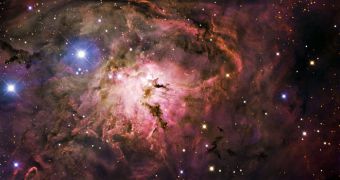For some time now, astronomers have been trying to figure out the source of the weak glow emanating from the interstellar space. In a study, experts now propose that the phenomenon is caused by the presence of solid hydrogen ice in that environment.
The finding followed from a series of previous observations, which revealed the presence of diffuse hydrogen gas permeating the observable Universe. Its presence was determined by analyzing the electromagnetic waves that the chemical emits.
Even as far back as the 1960s, astrophysicists proposed that the space between stars may in fact contain solid hydrogen ice, but that point of view was attacked by researchers who said that the ice should theoretically sublimate, regardless of the extreme cold temperatures at these locations.
But, in more recent times, astronomers began revisiting the 50-year-old theory, and this time the evidence appear to tip the scales in favor of solid hydrogen ice. A consensus is currently lacking in the scientific community, but the prevailing view is that the substance can indeed exist.
One of the factors that led investigators to this conclusion is the fact that recent chemical studies have demonstrated hydrogen ice to be a lot more stable than previously calculated, provided that it contains some amounts of impurities.
When the ice lattice receives the extra ions, it becomes a lot more stable, allowing the stuff to endure even at temperatures where it should theoretically sublimate into gas, Technology Review reports.
But this finding also raises an interesting question – how to you go about detecting a chemical that is, for all intents and purposes, transparent at visible-light wavelengths. A group of experts from the Australian National University in Canberra now provides an answer to this riddle.
The team, led by expert Ching Yeh, explains that photons bombarding the hydrogen ice ionize the lattice, forcing it to produce clusters of ionized hydrogen. The ion H6+ should be a common result.
Seeing how H6+ does not form in common hydrogen gas – of the type permeating the Universe – it stands to reason that finding it in interstellar space would be an indicator that hydrogen ice exists.
But this again raises a new problem. Experts have no clue as to how H6+ looks like, seeing how they were not even able to recreate it in the lab. But Yeh's team determined in their study that the ion should in fact produce emissions in the infrared portion of the electromagnetic spectrum.
The Universe produces a complex mixture of frequencies as a background noise. Collectively, these are known as diffuse interstellar bands (DIB), and their origin is still somewhat of a mystery.
The Australian team is proposing that some of the DIB may in fact be produced by H6+. “We conclude that serious consideration should be given to the possibility that solid H2 is abundant in the interstellar medium,” the team writes in a paper published in the journal arXiv.

 14 DAY TRIAL //
14 DAY TRIAL //